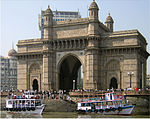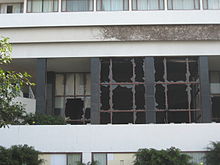- History of Bombay in Independent India
-
Mumbai (formerly Bombay) is the financial capital of India and one of the most populous cities in the world. Bombay grew into a leading commercial center of British India during the 19th century on the basis of textile mills and overseas trade.[1] After independence from British rule, the desire to domesticate cosmopolitan Bombay within a Marathi social and linguistic framework was strongly expressed in the 1950s.[2]
Contents
Background
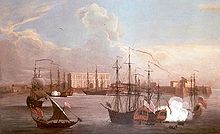 Ships in Bombay Harbour. Bombay grew into a leading commercial center of British India during the 19th century
Ships in Bombay Harbour. Bombay grew into a leading commercial center of British India during the 19th century Main article: History of Bombay under British rule
Main article: History of Bombay under British ruleThe seven islands that came to constitute Bombay were home to communities of the Kolis & East Indians. For centuries, the islands came under the control of successive indigenous empires before being ceded to the Portuguese and subsequently to the British East India Company. During the mid-18th century, Bombay was reshaped by the British with large-scale civil engineering projects, and emerged as a significant trading town.[3]
Bombay grew into a leading commercial center of British India during the 19th century on the basis of textile mills and overseas trade. The city was, first and foremost, built and developed by an indigenous industrial and commercial bourgeoisie consisting of Parsis, Gujarati Hindus, Muslims communities earning their wealth on the extensive Arabian trade, along with Jews, Armenians, Roman Catholics and others. The expanding labour force in Bombay was initially drawn from the coastal belt of Konkan, south of the city. After the famine in the Deccan during 1876–78, large numbers of Maratha-Kunbis and other peasent castes from the Deccan arrived in the city. Until the 1940s, Marathi speakers from these areas accounted for nearly half of the city's population, and held mostly manual and unskilled jobs. The business community was dominated by Parsi, Marwari, Muslim, and Gujarati merchants and industrialists, who owned most of the capital, and dominated the public and political life of Bombay in the 19th and first half of the 20th century.[1]
Bombay State (1947–1960)
Main articles: Bombay Presidency and Bombay State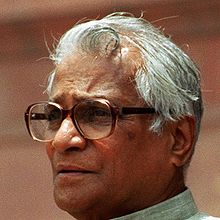 George Fernandes emerged as a key figure in the Bombay labour movement in the early 1950s
George Fernandes emerged as a key figure in the Bombay labour movement in the early 1950s
After India's independence from British rule on 15 August 1947, the territory of Bombay Presidency retained by India after the partition was restructured into Bombay State. The area of Bombay State increased, after several erstwhile princely states that joined the Indian union were integrated into Bombay State. Subsequently, Bombay City, the capital of erstwhile Bombay Presidency, became the capital of Bombay State.[4] Following communal riots between Hindus and Muslims in the Sindh province of the newly created Pakistan from Bombay Presidency, over 100,000 Sindhi Hindu refugees from Pakistan were relocated in the military camps five kilometres from Kalyan in the Bombay metropolitan region. It was converted into a township in 1949, and named Ulhasnagar by the then Governor-General of India, C. Rajagopalachari.[5]
In 1947, Congress party activists established the Rashtriya Mazdoor Mill Sangh (RMMS), with a claimed membership of 32,000, to ensure a strong political base in the textile industry. The RMMS served as a lasting impediment to the free development of independent unionism in Bombay.[6] Economic growth in India was relatively strong during much of the 1950s, and employment growth in Bombay was particularly good, as the city's manufacturing sector diversified.[6] The Bombay textile industry until the 1950s was largely homogeneous, dominated by a relatively small number of large industrial mills. From the late 1950s, policies were introduced to curb the expansion of mills and to encourage increased production from the handloom and powerloom sectors, because of their employment generating capacities.[7] Bombay was one of the few industrial centres of India where strong unions grew up, particularly company or enterprise based unions, often in foreign owned firms.[6] A key figure in the Bombay labour movement in the early 1950s, was George Fernandes. He was a central figure in the unionisation of sections of Bombay labour in the 1950s.[7]
 The Indian Institute of Technology Bombay, one of the finest institutions in the country in science and technology, was established in 1958
The Indian Institute of Technology Bombay, one of the finest institutions in the country in science and technology, was established in 1958
Bombay's Bollywood film industry grew rapidly as it received intense political attention and new sources of governmental funding after 1947. This enabled the industry to embark on technological innovations and to establish effective systems for nationwide distributions. The enormous growth in spectatorship and cinema halls throughout the country soon established Bombay cinema as the dominant Indian film industry.[8] In April 1950, Greater Bombay District came into existence with the merger of Bombay Suburbs and Bombay City. It spanned an area of 235.1 km2 (90.77 sq mi) and inhabited 23.39 lakhs of people in 1951. The Municipal Corporation limits were extended up to Jogeshwari along the Western Railway and Bhandup along the Central Railway. This limit was further extended in February 1957 up to Dahisar along the Western Railway and Mulund on the Central Railway.[9] The Indian Institute of Technology Bombay, one of the finest institutions in the country in science and technology, was established in 1958 at Powai, a northern suburb of Bombay, with assistance from UNESCO and with funds contributed by the Soviet Union.[10][11]
Battle of Bombay
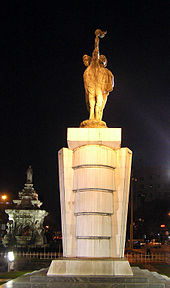 Flora Fountain was renamed Hutatma Chowk ("Martyr's Square") as a memorial to the Samyukta Maharashtra movement. The Hutatma Chowk memorial with the Flora Fountain, on its left in the background
Flora Fountain was renamed Hutatma Chowk ("Martyr's Square") as a memorial to the Samyukta Maharashtra movement. The Hutatma Chowk memorial with the Flora Fountain, on its left in the background
The desire to domesticate cosmopolitan Bombay within a Marathi social and linguistic framework was strongly expressed in the 1950s.[2] On 13 May 1946, a session of the Marathi literary conference held at Belgaum, unanimously resolved on the formation of a united Marathi state. Consequently, the Samyukta Maharashtra Parishad (United Maharashtra Conference) was formed on 28 September 1946, to unite all Marathi-speaking territories into a single political unit.[12] The Parishad consisted of political leaders from the Congress and other parties, and prominent literary figures.[13] It presented its point of view to the States Reorganisation Committee. The States Reorganisation Committee, which has submitted its report to the Indian Government in 1955, recommended a bilingual state for Maharashtra–Gujarat with Bombay as its capital. The report also respected Gujarati susceptibilities over Bombay City. The Maharashtrians wanted Bombay as a part of Maharashtra, since it had majority of Marathi speakers.[12] However, the city's economic and political elite feared that Bombay would decline under a government committed to developing the rural hinterland.[14] Bombay Citizens' Committee, an advocacy group composed of leading Gujarati industrialists lobbied for Bombay's independent status.[15]
In the Lok Sabha discussions on 15 November 1955, S. K. Patil, a Marathi-speaking Congress Member of Parliament (MP) from Bombay, demanded that the city be constituted as an autonomous city-state, laying great stress on its cosmopolitan character.[16] On 20 November 1955, the Bombay Pradesh Congress Committee organized a public meeting at the Chowpatty beach in Bombay, where S. K. Patil and Congressman Morarji Desai, the then Chief Minister of Bombay State, made provocative statements on Bombay.[17] Patil said that, "Maharashtra will not get Bombay for the next 5,000 years."[18] On 21 November 1955, violent outbursts erupted, and there was a total hartal in Bombay. Thousands of angry protesters converged at Flora Fountain with a view to march peacefully towards the Council Hall, where the State Legislature was in session.[19][20] The police used tear gas to disperse the crowd, but when it failed, they finally resorted to firing, killing 15 people.[21] Under pressure from business interests in Bombay, it was decided to grant Bombay the status of a Union territory under a centrally-governed administration, setting aside the recommendations of the States Reorganisation Committee report. On 16 January 1956, Jawaharlal Nehru, the first Prime Minister of India, announced the government's decision to create separate states of Maharashtra and Gujarat, but put Bombay City under central administration. Large demonstrations, mass meetings and riots soon followed. The Bombay Police dissolved the mass meetings and arrested several of the movement's leaders. During 16 January–22 January, police fired at demonstrators protesting the arrests, in which more than 80 people were killed.[14][22][23]
Part of a series on the
History of MumbaiPre-historic period Ancient period Islamic period Gujarat Sultanate
Haji Ali Mosque
Treaty of BasseinPortuguese period St. Michael's Church
British period Hornby Vellard
Treaty of Salbai
Plague epidemic of 1890s
Rowlatt Satyagraha
Royal Indian Navy MutinyIndependent India Samyukta Maharashtra movement
Bombay Riots
1993 bombings
2005 Floods
2006 train bombings
2008 terrorist attacksThe States Reorganisation Committee report was to be implemented on 1 November 1956. It caused a great political stir and, led to the establishment of the Samyukta Maharashtra Samiti (United Maharashtra Committee) on 6 February 1956.[24] The Samyukta Maharashtra Samiti was basically born from the Samyukta Maharashtra Parishad, but had an enlarged identity with broad representation from not only the Congress, but opposition parties, and independents as well.[25] The Samiti spearheaded the demand for the creation of a separate Maharashtra state including Bombay out of the bilingual Bombay State using violent means.[26] In the August 1956 discussions, the Union cabinet agreed on the creation of a bigger bilingual Bombay State including Maharashtra, Marathwada, Vidharbha, Gujarat, Saurashtra, Kutch, and Bombay City.[27] In the second general elections of Bombay State held in 1957, the Samiti secured a majority of 101 seats out of 133 in Maharashtra. The Congress could secure only 32 seats out of 133 in Maharashtra, obtaining a bare majority of 13 out of 24 in Greater Bombay. The Congress suffered the same fate in Gujarat, winning only 57 out of 89 seats.[28] The Congress however succeeded in forming a government in Bombay State with the support of Marathwada and Vidarbha. Yashwantrao Chavan became the first Chief Minister of the bilingual Bombay State.[24] In 1959, he headed a cabinet of 15, out of which 4 represented Gujarat, to discuss the future of Bombay State. Chavan managed in convincing Jawaharlal Nehru and Indira Gandhi, who was elected President of the Indian National Congress in 1959, of the futility of the bilingual Bombay State, which was increasingly jeopardizing Congress prospects in Gujarat and Maharashtra.[29] Finally on 4 December 1959, the Congress Working Committee (CWC) passed a resolution recommending the bifurcation of the Bombay State.[30]
The Samyukta Maharashtra Samiti achieved its goal when Bombay State was reorganised on linguistic lines on 1 May 1960.[31] Gujarati-speaking areas of Bombay State were partitioned into the state of Gujarat.[32] Maharashtra State with Bombay as its capital was formed with the merger of Marathi-speaking areas of Bombay State, eight districts from Central Provinces and Berar, five districts from Hyderabad State, and numerous princely states enclosed between them.[33] The pro-Samyukta Maharashtra writers claimed that in all 105 persons died in the battle for Bombay.[34] As a memorial to the martyrs of the Samyukta Maharashtra movement, Flora Fountain was renamed as Hutatma Chowk (Martyr's Square), and a memorial was erected, since it was the starting point of the agitation.[35]
1960s
After the 1960 bifurcation, many Gujaratis left Bombay feeling that they would be better-off in Gujarat than in Bombay, and fearing that they would be neglected by the Maharashtra Government.[36] The Maharashtrians also blamed the Gujaratis for the death of the 105 martyrs of the Samyukta Maharashtra movement.[14] When large number of Marathi speakers arrived in Bombay after the creation of Maharashtra, they found themselves at the lower rungs of the labour market and in competition with skilled communities from other parts of India. The Marathi-speaking middle-class in Bombay, who had been the most consistent supporters of the Samyukta Maharashtra Samiti, also experienced similar discrepancies.[37] The Gujarati and Marwari communities owned majority of the industry and trade enterprises in the city, while the white-collar jobs were mainly sought by the South Indian migrants to the city.[38] This was the line taken by Bombay cartoonist and journalist Bal Thackeray in his weekly magazine Marmik (Satire), launched in 1963.[39] The Shiv Sena party was established on 19 June 1966 by Bal Thackeray, out of a feeling of resentment about the relative marginalization of Maharashtrians in Bombay.[38]
With Bombay at breaking point in terms of congestion and living space, the Bombay Metropolitan Regional Planning Board took steps in 1967 to promote a New Bombay on the mainland. The proposed site for New Bombay covered an area of 344 km2 (133 sq mi), integrating 95 villages spread over the districts of Thane and Raigad.[40]
21st century
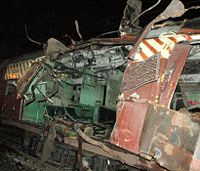 One of the bomb-damaged coaches at the Mahim station in Mumbai during the 11 July 2006 train bombings
One of the bomb-damaged coaches at the Mahim station in Mumbai during the 11 July 2006 train bombings
During the 21st century, the city suffered several bombings. On 6 December 2002, a bomb placed under a seat of an empty BEST (Brihanmumbai Electric Supply and Transport) bus exploded near Ghatkopar station in Mumbai. Around 2 people were killed and 28 were injured.[41] The bombing occurred on the tenth anniversary of the demolition of the Babri Mosque in Ayodhya.[42] On 27 January 2003, a bomb placed on a bicycle exploded near the Vile Parle station in Mumbai. The bomb killed 1 and injured 25. The blast occurred a day ahead of the visit of Atal Bihari Vajpayee, the then Prime Minister of India to the city.[43] On 13 March 2003, a bomb exploded in a train compartment, as the train was entering the Mulund station in Mumbai. 10 people were killed and 70 were injured. The blast occurred a day after the tenth anniversary of the 1993 Bombay bombings.[44] On 28 July 2003, a bomb placed under a seat of a BEST bus exploded in Ghatkopar. The bomb killed 4 people and injured 32.[45] On 25 August 2003, two blasts in South Mumbai - one near the Gateway of India and the other at Zaveri Bazaar in Kalbadevi occurred. At least 44 people were killed and 150 injured. No group claimed responsibility for the attack, but it had been hinted that the Pakistan-based Lashkar-e-Toiba was behind the attacks.[46]
Mumbai was lashed by torrential rains on 26–27 July 2005, during which the city was brought to a complete standstill. The city received 37 inches (940 millimeters) of rain in 24 hours — the most any Indian city has ever received in a single day. Around 83 people were killed.[47] On 11 July 2006, a series of seven bomb blasts took place over a period of 11 minutes on the Suburban Railway in Mumbai at Khar, Mahim, Matunga, Jogeshwari, Borivali, and one between Khar and Santa Cruz.[48] 209 people were killed[49] and over 700 were injured.[50] According to Mumbai Police, the bombings were carried out by Lashkar-e-Toiba and Students Islamic Movement of India (SIMI).[51] In 2008, the city experienced xenophobic attacks by the activists of the Maharashtra Navnirman Sena (MNS) under Raj Thackeray on the North Indian migrants in Mumbai.[52] Attacks included assault on North Indian taxi drivers and damage of their vehicles.[53] There were a series of ten coordinated terrorist attacks by 10 armed Pakistani men using automatic weapons and grenades which began on 26 November 2008 and ended on 29 November 2008. The attacks resulted in 164 deaths, 308 injuries, and severe damage to several important buildings.[54]
References
- ^ a b Hansen 2001, p. 38
- ^ a b Hansen 2001, p. 37
- ^ "Bombay: History of a City". British Library. http://www.bl.uk/learning/histcitizen/trading/bombay/history.html. Retrieved 2008-11-08.
- ^ * Census of India, 1961. 5. Office of the Registrar General (India). 1962. p. 23.
- ^ Alexander, Horace Gundry (1951). New Citizens of India. Indian Branch, Oxford University Press. p. 65.
- ^ a b c Hutchison & Brown 2001, p. 157
- ^ a b Hutchison & Brown 2001, p. 158
- ^ Hansen 2001, p. 39
- ^ "Administration". Mumbai Suburban District. http://mumbaisuburban.gov.in/html/administrative_setup.htm. Retrieved 2008-11-06.
- ^ "About IIT Bombay". Indian Institute of Technology Bombay. http://www.iitb.ac.in/about/aboutiitb.html. Retrieved 2008-11-13.
- ^ "History of IIT Bombay". Indian Institute of Technology Bombay. http://www.iitb.ac.in/about/how.html. Retrieved 2008-11-13.
- ^ a b Sharma 1995, p. 187
- ^ Economic and political weekly. 15. Sameeksha Trust. 1980. p. 1628.
- ^ a b c Hansen 2001, p. 42
- ^ Guha, Ramachandra (2007). India after Gandhi. HarperCollins. pp. 197–8.
- ^ Guha, Ramachandra (2003-04-13). "The battle for Bombay". The Hindu. http://www.hinduonnet.com/thehindu/mag/2003/04/13/stories/2003041300240300.htm. Retrieved 2008-11-12.
- ^ Phadke, Y. D. (1981). Senapati Bapat portrait of a revolutionary. Senapati Bapat Centenary Celebration Samiti. p. 86.
- ^ Indian Parliament, House of the People, Lok Sabha (1955). Lok Sabha debates, Part 2, Volume 10. Lok Sabha Secretariat. p. 2858.
- ^ Sirsikar, V. M. (1995). Politics of modern Maharashtra (illustrated ed.). Orient Longman. p. 39. ISBN 9788125003328.
- ^ Lok Sabha debates: Appendix, Issues 1-7. Indian Parliament, Lok Sabha. 1955. p. 68.
- ^ Indian Parliament, Lok Sabha (1955). Lok Sabha debates, Part 2, Volume 9. Lok Sabha Secretariat. p. 265.
- ^ Economic and political weekly. 15. Sameeksha Trust. 1980. p. 1628.
- ^ Bernard, Jean Alphonse (2001). From raj to the republic: a political history of India, 1935-2000. Har Anand Publications. p. 189.
- ^ a b "Samyukta Maharashtra". Government of Maharashtra. http://www.maharashtra.gov.in/english/community/community_samyuktaShow.php. Retrieved 2008-11-12.
- ^ Dandavate, Madhu (2005). Dialogue with Life. Allied Publishers. p. 37. ISBN 9788177648560.
- ^ Sharma 1995, p. 188
- ^ Sharma 1995, p. 189
- ^ Sharma 1995, p. 190
- ^ Sharma 1995, p. 191
- ^ Sharma 1995, p. 183
- ^ "Sons of soil: born, reborn". Indian Express Newspapers (Mumbai). 2008-02-06. http://www.indianexpress.com/news/sons-of-soil-born-reborn/269628/. Retrieved on 2008-11-12.
- ^ "Gujarat". Government of India. http://india.gov.in/knowindia/st_gujurat.php. Retrieved 2008-01-16.
- ^ "Maharashtra". Government of India. http://india.gov.in/knowindia/st_maharashtra.php. Retrieved 2008-01-16.
- ^ Phadke, Y. D. (1979). Politics and language. Himalaya Publishing House. p. 155.
- ^ Desai, Geeta (2008-05-13). "BMC will give jobs to kin of Samyukta Maharashtra martyrs". Mumbai Mirror. http://epaper.timesofindia.com/Repository/ml.asp?Ref=TU1JUi8yMDA4LzA1LzEzI0FyMDA1MDA=&Mode=HTML&Locale=english-skin-custom. Retrieved 2008-11-16.
- ^ Streefkerk, Hein (1985). Industrial transition in rural India: artisans, traders, and tribals in South Gujarat (illustrated ed.). Popular Prakashan. pp. 53–54. ISBN 9780861320677.
- ^ Hansen 2001, p. 45
- ^ a b "Sena fate: From roar to meow". The Times of India. 2005-11-29. http://timesofindia.indiatimes.com/articleshow/msid-1311115,prtpage-1.cms. Retrieved 2008-11-12.
- ^ Hansen 2001, p. 46
- ^ "To the Present". Hindustan Times. http://www.hindustantimes.com/news/specials/bombay/history5.shtml. Retrieved 2008-11-13.
- ^ "Blast outside Ghatkopar station in Mumbai, 2 killed". rediff.com India Limited. 2002-12-06. http://www.rediff.com/news/2002/dec/02mum.htm. Retrieved 2008-08-19.
- ^ "1992: Mob rips apart mosque in Ayodhya". BBC. 1992-12-06. http://news.bbc.co.uk/onthisday/hi/dates/stories/december/6/newsid_3712000/3712777.stm. Retrieved 2008-11-11.
- ^ "1 killed, 25 hurt in Vile Parle blast". The Times of India. 2003-01-28. http://timesofindia.indiatimes.com/articleshow/35711165.cms. Retrieved 2008-08-19.
- ^ "Fear after Bombay train blast". BBC. 2003-03-14. http://news.bbc.co.uk/2/hi/south_asia/2848123.stm. Retrieved 2008-08-19.
- ^ Vijay Singh, Syed Firdaus Ashra (2003-07-29). "Blast in Ghatkopar in Mumbai, 4 killed and 32 injured". rediff.com India Limited. http://www.rediff.com/news/2003/jul/28blast.htm. Retrieved 2008-08-19.
- ^ "2003: Bombay rocked by twin car bombs". BBC. 2003-08-25. http://news.bbc.co.uk/onthisday/hi/dates/stories/august/25/newsid_3921000/3921475.stm. Retrieved 2008-08-19.
- ^ "Maharashtra monsoon 'kills 200'". BBC. 2005-07-25. http://news.bbc.co.uk/2/hi/south_asia/4720343.stm. Retrieved 2008-08-17.
- ^ "At least 174 killed in Indian train blasts". CNN. 2006-07-11. http://www.cnn.com/2006/WORLD/asiapcf/07/11/mumbai.blasts/. Retrieved 2008-11-11.
- ^ "India: A major terror target". The Times of India. 2008-10-30. http://timesofindia.indiatimes.com/India/India_A_major_terror_target_/articleshow/3654886.cms. Retrieved 2008-11-11.
- ^ "'Rs 50, 000 not enough for injured'". Indian Express Newspapers (Mumbai) Ltd.. 2006-07-21. http://www.expressindia.com/news/fullstory.php?newsid=71404. Retrieved 2008-11-11.
- ^ "India police: Pakistan spy agency behind Mumbai bombings". CNN. 2006-10-01. http://www.cnn.com/2006/WORLD/asiapcf/09/30/india.bombs/index.html?section=cnn_world#. Retrieved 2008-11-11.
- ^ "Thackeray continues tirade against North Indians". Daily News & Analysis. 2008-02-16. http://www.dnaindia.com/report.asp?newsid=1151247. Retrieved 2008-08-19.
- ^ "North Indian taxi drivers attacked in Mumbai". NDTV. 2008-03-29. http://www.ndtv.com/convergence/ndtv/story.aspx?id=NEWEN20080045337. Retrieved 2008-08-19.
- ^ "HM announces measures to enhance security" (Press release). Press Information Bureau (Government of India). 2008-12-11. http://pib.nic.in/release/release.asp?relid=45446. Retrieved 2008-12-14.
- Hansen, Thomas Blom (2001). Wages of violence: naming and identity in postcolonial Bombay. Princeton University Press. ISBN 9780691088402.
- Hutchison, Jane; Brown, Andrew (2001). Organising labour in globalising Asia (illustrated ed.). Routledge. ISBN 9780415250603.
- Sharma, Sadhna (1995). States politics in India. Mittal Publications. ISBN 9788170996194.
Categories:- History of Mumbai
- Independent India
Wikimedia Foundation. 2010.

